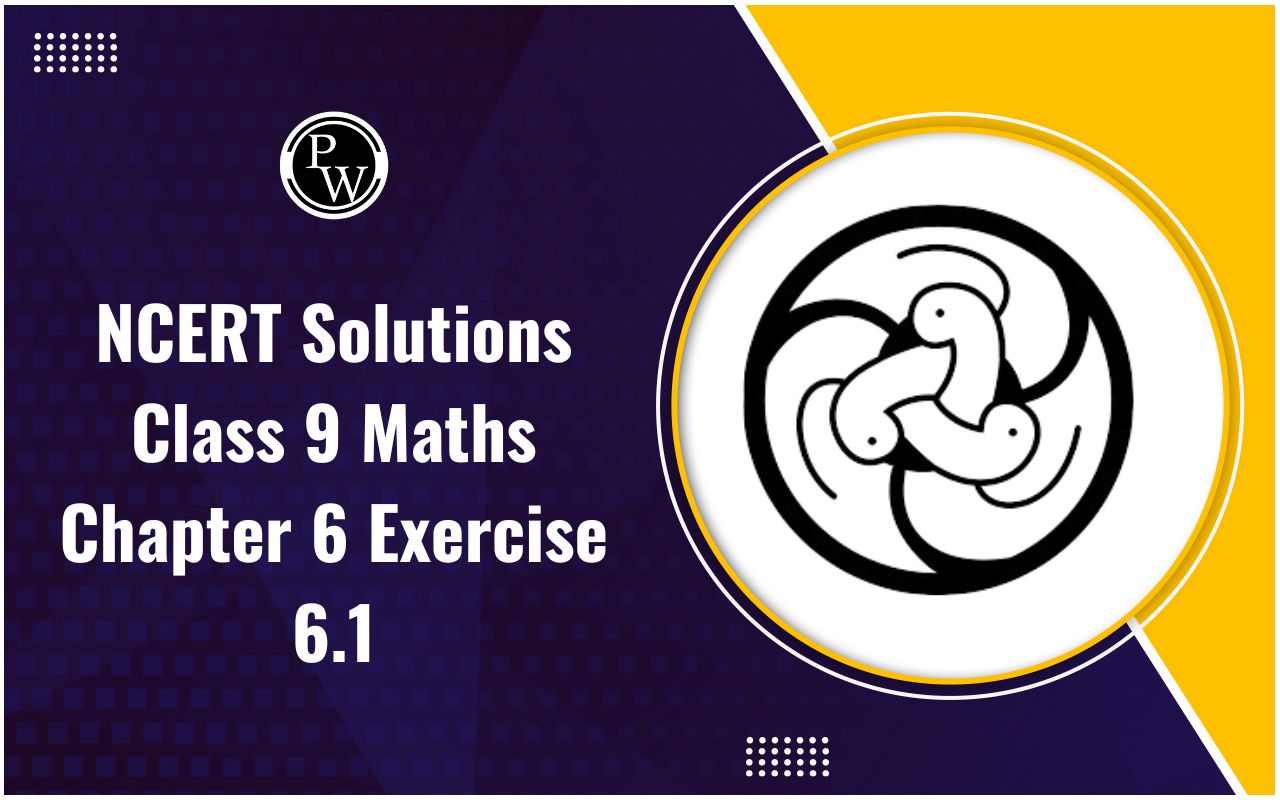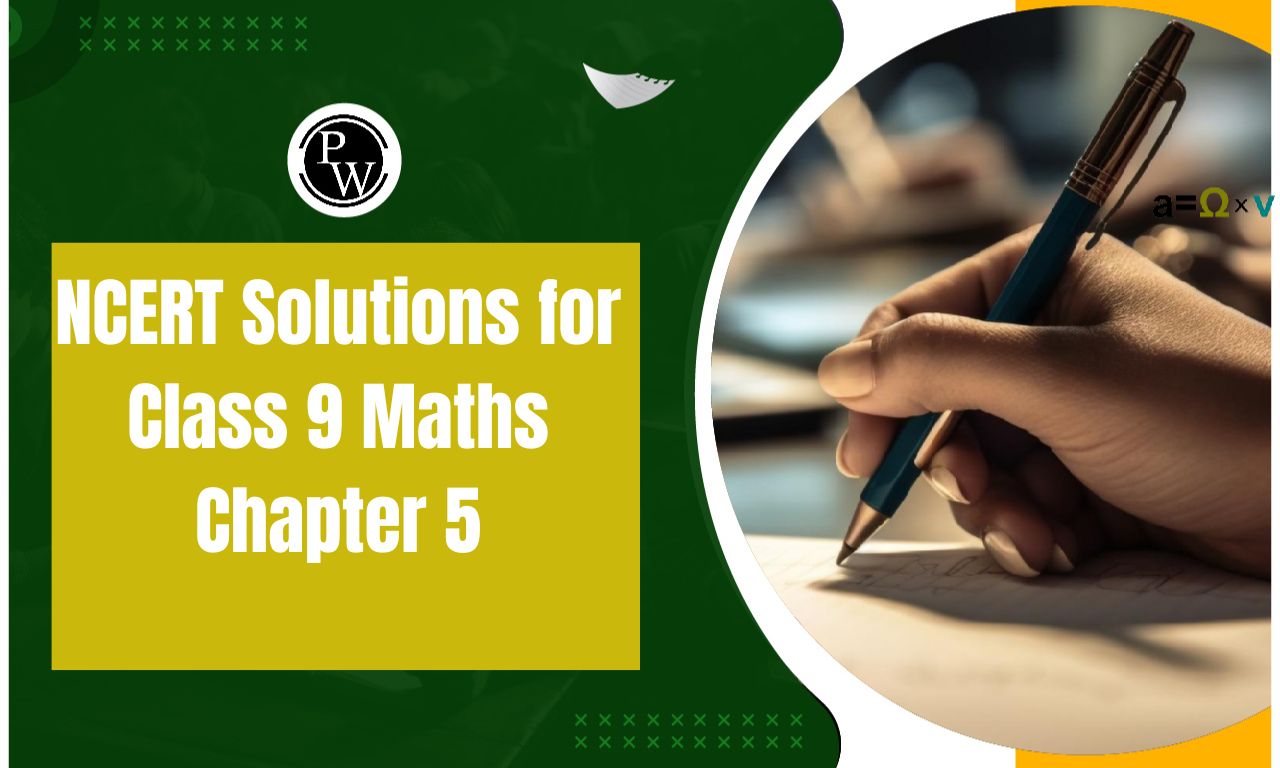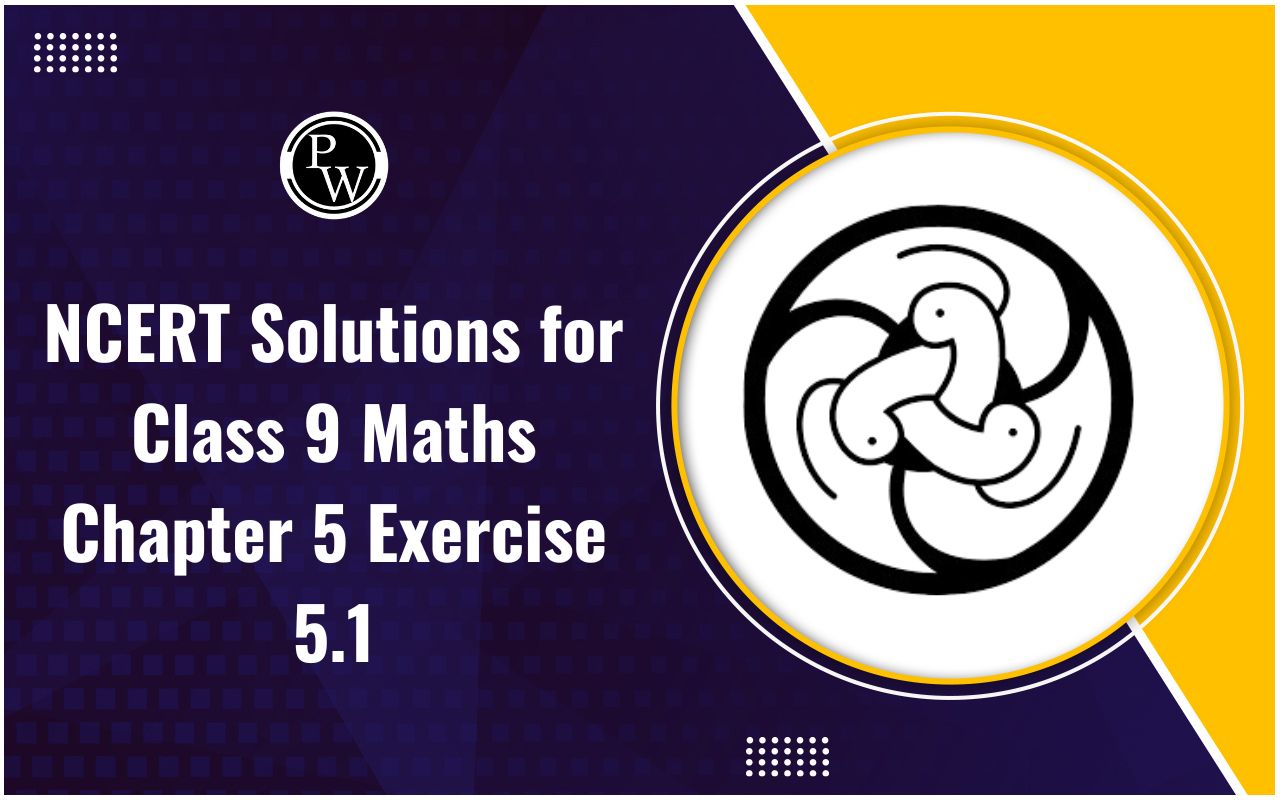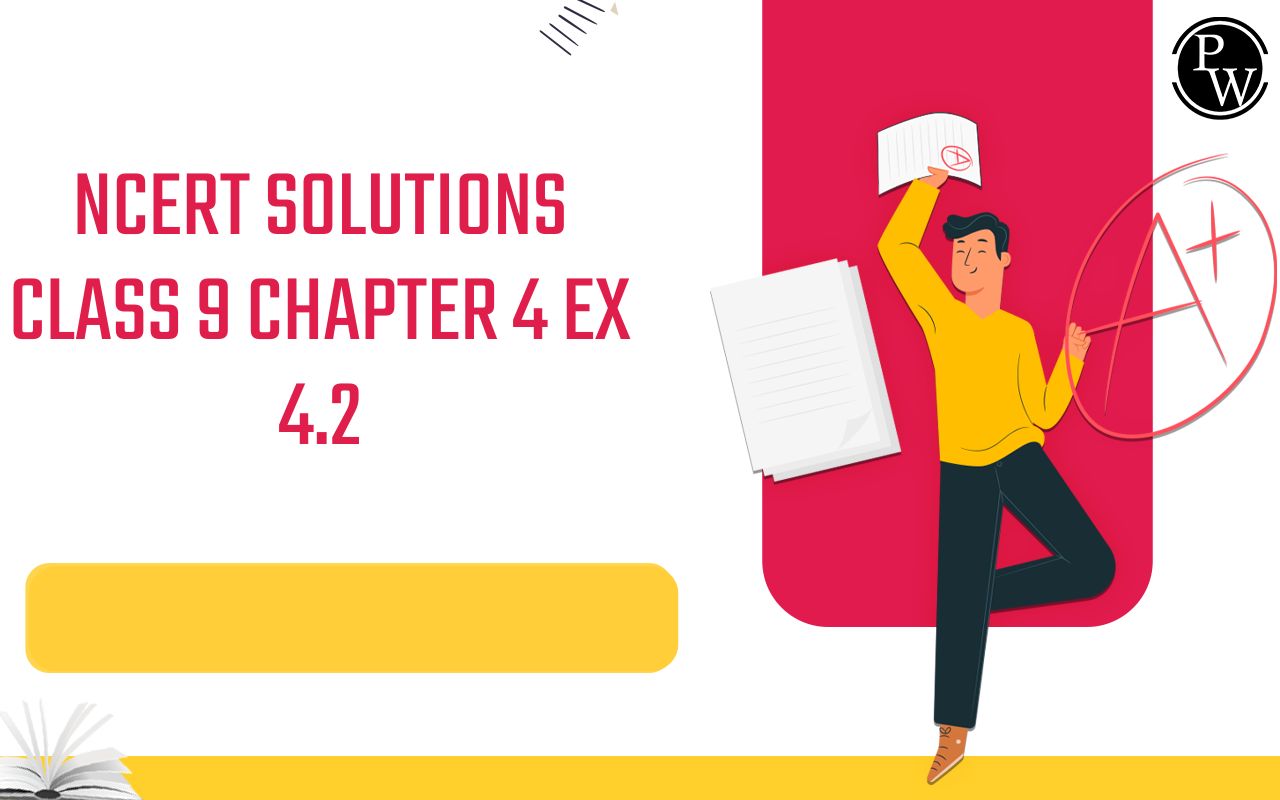
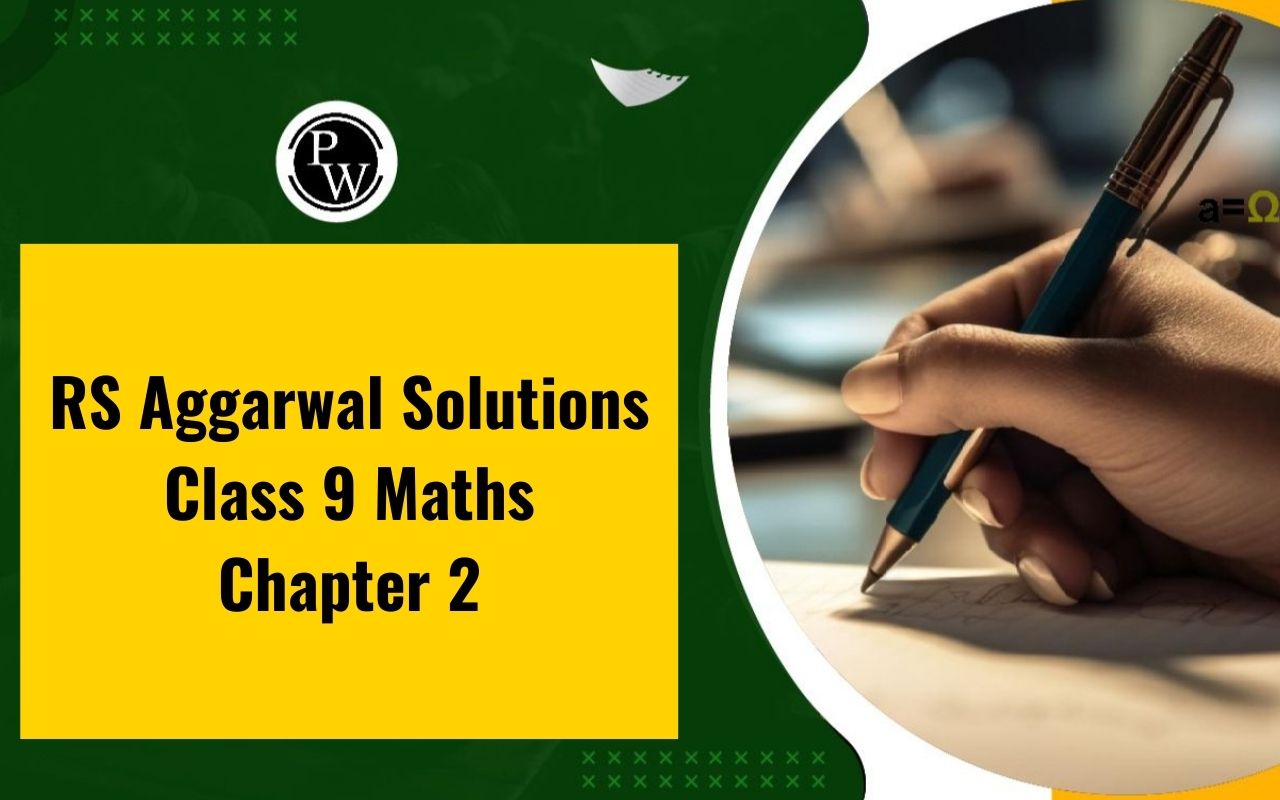
RS Aggarwal Solutions Class 9 Maths Chapter 2: RS Aggarwal Solutions for Class 9 Maths Chapter 2 - Polynomials are helpful guides for students to understand and solve polynomial-related problems easily. This chapter covers different topics like polynomial expressions, degrees of polynomials, and basic operations such as addition, subtraction, multiplication, and division of polynomials.
These solutions provide step-by-step explanations and examples to make learning easier for students. Whether you're preparing for exams or just want to improve your math skills, these solutions are here to support you every step of the way.RS Aggarwal Solutions Class 9 Maths
RS Aggarwal Solutions Class 9 Maths Chapter 2 - Polynomials PDF
You can access the PDF version of RS Aggarwal Solutions for Class 9 Maths Chapter 2 - Polynomials through the link provided below. This PDF contains detailed solutions to all the questions in the chapter, making it convenient for students to study and revise the concepts covered.RS Aggarwal Solutions Class 9 Maths Chapter 2 - Polynomials PDF
RS Aggarwal Solutions Class 9 Maths Chapter 2 - Polynomials
The solutions for RS Aggarwal Class 9 Maths Chapter 2 - Polynomials are provided below. These solutions provide detailed explanations and step-by-step guidance to help students understand the concepts effectively. By referring to these solutions, students can clarify their doubts and strengthen their understanding of polynomial expressions and equations.RS Aggarwal Solutions Class 9 Chapter 2 - Polynomials (Ex 2A) Exercise 2.1
Question 1.
Solution:
(i) x 5−2x 3+x+√3 is an expression having only non-negative integral powers of x. So, it is a polynomial. Also, the highest power of x is 5, so, it is a polynomial of degree 5. (ii) y 3+√3y is an expression having only non-negative integral powers of y. So, it is a polynomial. Also, the highest power of y is 3, so, it is a polynomial of degree 3. (iii) t 2−2/5t+√5 is an expression having only non-negative integral powers of t. So, it is a polynomial. Also, the highest power of t is 2, so, it is a polynomial of degree 2. (iv) x 100−1 is an expression having only non-negative integral power of x. So, it is a polynomial. Also, the highest power of x is 100, so, it is a polynomial of degree 100. (v) 1√2 x 2 −–√2x + 2 is an expression having only non-negative integral powers of x. So, it is a polynomial. Also, the highest power of x is 2, so, it is a polynomial of degree 2. (vi) x −2 + 2x−1 + 3 is an expression having negative integral powers of x. So, it is not a polynomial. (vii) Clearly, 1 is a constant polynomial of degree 0. (viii) Clearly, −3/5 is a constant polynomial of degree 0. (ix) x2/2−2/x2 This is an expression having negative integral power of x i.e. −2. So, it is not a polynomial. (x) 3√2x2 – 8 is an expression having only non-negative integral power of x. So, it is a polynomial. Also, the highest power of x is 2, so, it is a polynomial of degree 2. (xi) 1/2x2 is an expression having negative integral power of x. So, it is not a polynomial. (xii) 1/√5x1/2 +1 In this expression, the power of x is 1/2 which is a fraction. Since it is an expression having fractional power of x, so, it is not a polynomial. (xiii) 3/5x2−7/3x + 9 is an expression having only non-negative integral powers of x. So, it is a polynomial. Also, the highest power of x is 2, so, it is a polynomial of degree 2. (xiv) x 4−x 3/2 + x−3 In this expression, one of the powers of x is 3/2 which is a fraction. Since it is an expression having fractional power of x, so, it is not a polynomial. (xv) 2x3 + 3x2+√x−1 In this expression, one of the powers of x is 1⁄2 which is a fraction. Since it is an expression having fractional power of x, so, it is not a polynomial.Question 2.
Solution:
(i) –7 + x is a polynomial with degree 1. So, it is a linear polynomial. (ii) 6y is a polynomial with degree 1. So, it is a linear polynomial. (iii) –z 3 is a polynomial with degree 3. So, it is a cubic polynomial. (iv) 1 – y – y3 is a polynomial with degree 3. So, it is a cubic polynomial. (v) x – x3 + x4 is a polynomial with degree 4. So, it is a quartic polynomial (vi) 1 + x + x 2 is a polynomial with degree 2. So, it is a quadratic polynomial. (vii) – 6x2 is a polynomial with degree 2. So, it is a quadratic polynomial. (viii) –13 is a polynomial with degree 0. So, it is a constant polynomial. (ix) – p is a polynomial with degree 1. So, it is a linear polynomial.Question 3.
Solution:
(i) The coefficient of x3 in x+3x 2−5x3+x4 is −5. (ii) The coefficient of x in √3−2√2x+6x2 is −2√2. (iii) 2x – 3 + x3 = – 3 + 2x + 0x 2 + x3 The coefficient of x2 in 2x – 3 + x3 is 0. (iv) The coefficient of x in 3/8x2−2/7x+1/6 is −2/7. (v) The constant term in π/2 x2 +7x−2/5π is −2/5πRS Aggarwal Solutions Class 9 Chapter 2 - Polynomials Exercise 2.2
Question 1.
Solution:
(i) p(x)=5−4x+2x2 ⇒p(0)=(5−4×0+2×02) =(5−0+0)=5 (ii) p(x)=5−4x+2x2 ⇒p(3)=(5−4×3+2×32) =(5−12+18)=11 (iii) p(x)=5−4x+2x2 ⇒p(−2) =[5−4×(−2)+2×(−2) 2] =(5+8+8)=21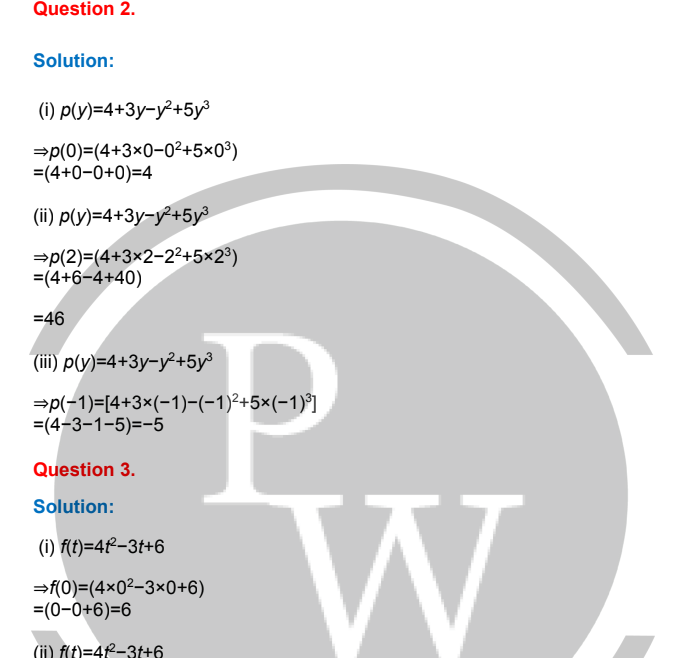
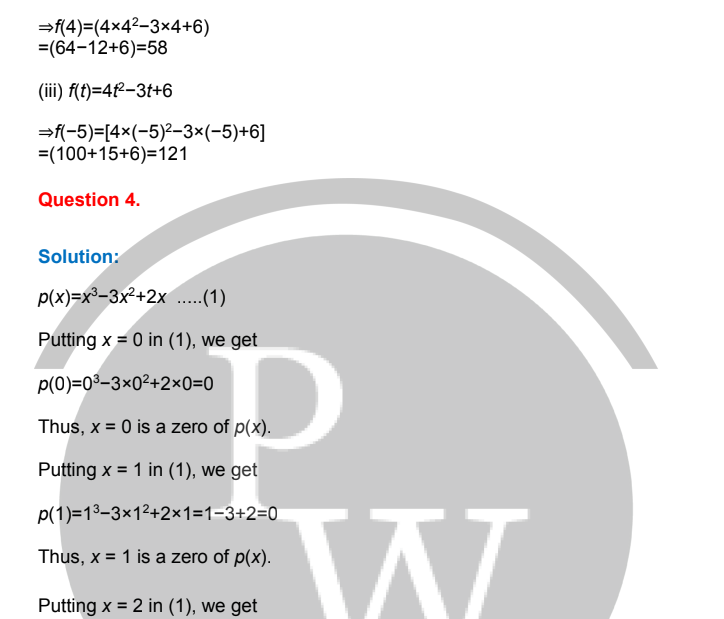

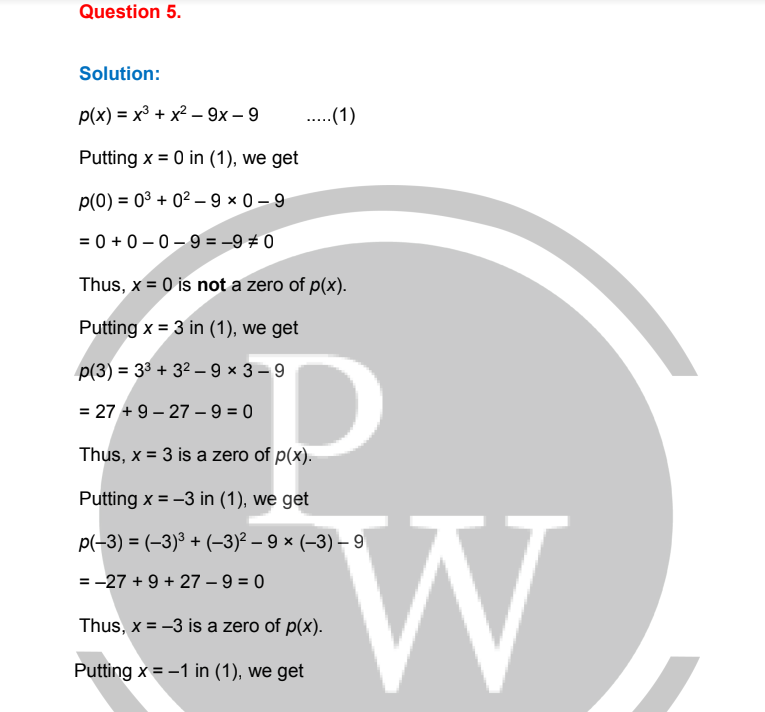
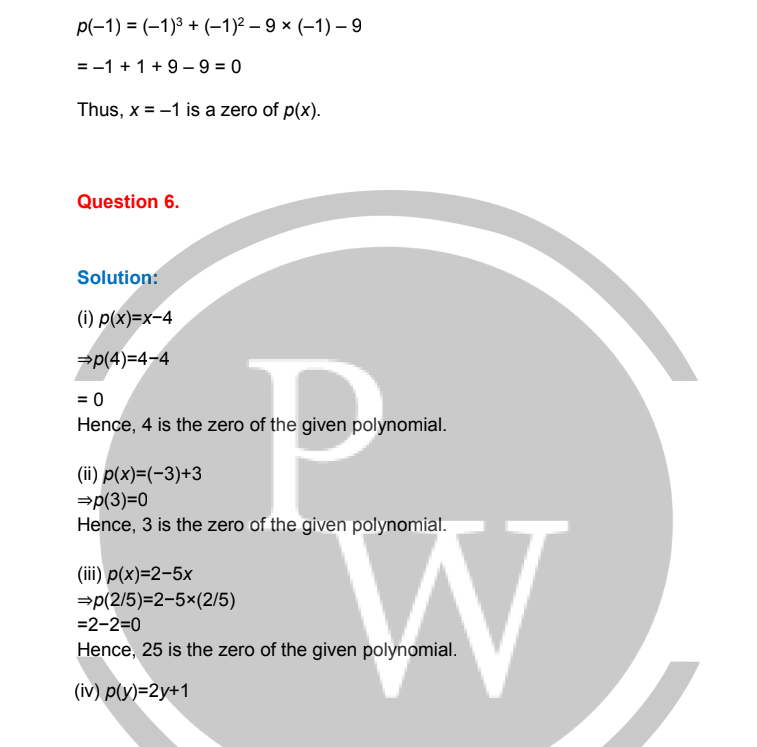

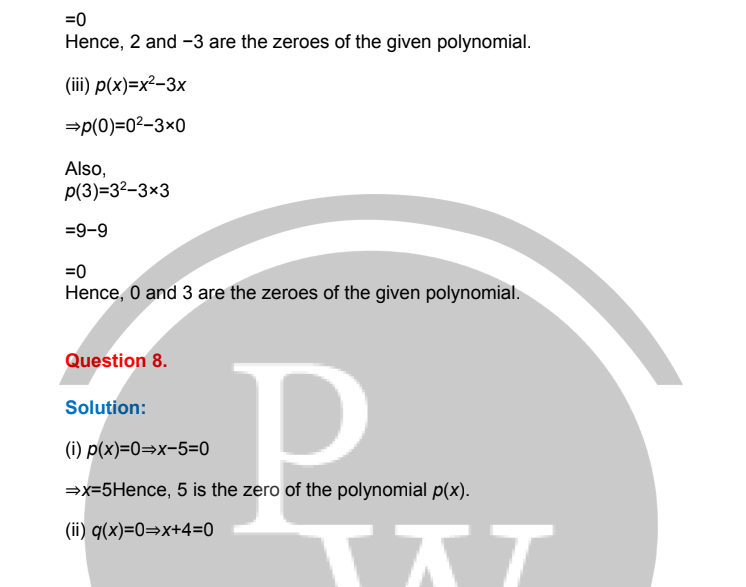
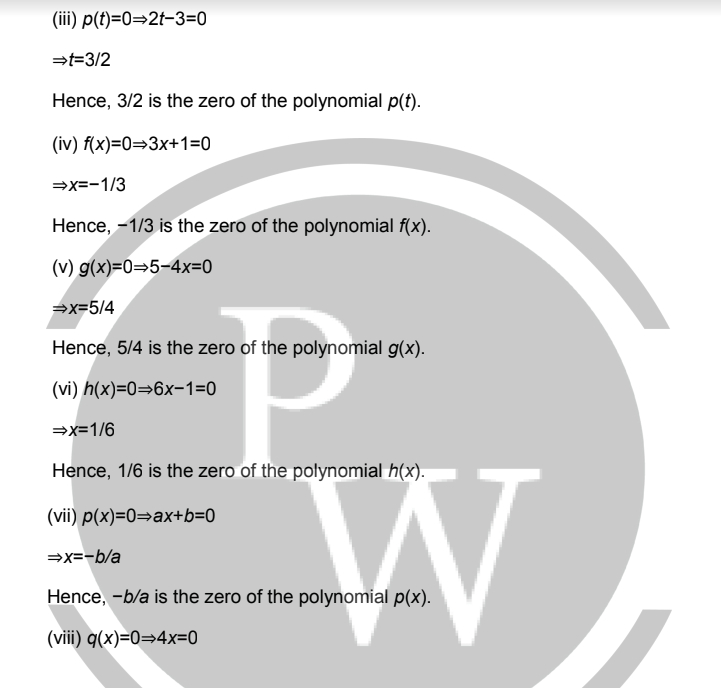
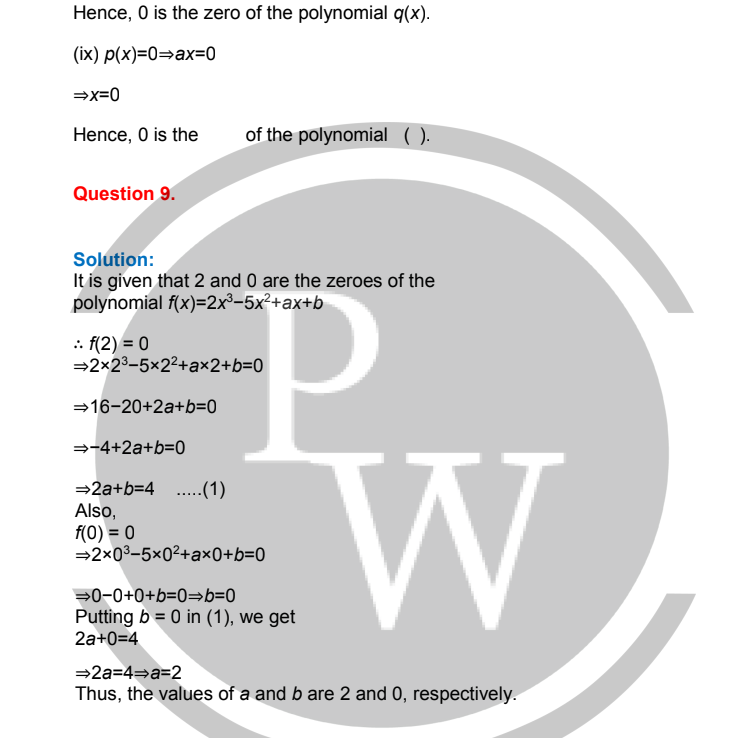
RS Aggarwal Solutions Class 9 Chapter 2 - Polynomials Exercise 2.5
Question 1.
Solution:
9x2 + 12xy= 3x (3x + 4y)Question 2.
Solution:
18x2y – 24xyz = 6xy (3x – 4z)Question 3.
Solution:
27a3b 3 – 45a4b 2= 9a3b 2 (3b – 5a)Question 4.
Solution:
2a (x + y) – 3b(x + y) = (x + y) (2a – 3b)Question 5.
Solution:
2x (p2 + q2) + 4y (p2 + q2)= 2(p2 + q2 ) (x + 2y) AnsQuestion 6.
Solution:
x (a – 5) + y (5 – a) = x (a – 5) -y (a – 5) = (a – 5) (x – y)Question 7.
Solution:
4(a + b) – 6 (a + b)2 = 2(a + b) {2 – 3 (a + b)} = 2(a + b) (2 – 3a – 3b)Question 8.
Solution:
8(3a – 2b)2 – 10 (3a – 2b) = 2(3a – 2b) {4 (3a – 2b) – 5} = 2(3a – 2b) (12a – 8b – 5)Question 9.
Solution:
x (x + x)3 – 3x2 y (x + y) = x (x + y) {(x + y)2 – 3xy} = x (x + y) [x2 + y2 + 2xy – 3xy) = x (x + y) (x2 + y2 – xy)Question 10.
Solution:
x 3 + 2x2 + 5x + 10= x2 (x + 2) + 5 (x + 2) = (x + 2) (x2 + 5)Question 11.
Solution:
x 2 + xy – 2xz – 2yz = x (x + y) -2z (x + y) = (x + y) (x – 2z)
Question 16.
Solution:
x 2 + y – xy – x = x2 – x – xy + y = x (x – 1) – y (x – 1) = (x – 1) (x – y)
Question 20.
Solution:
3ax – 6ay – 8by + 4bx = 3ax – 6ay + 4bx – 8by = 3a (x – 2y) + 4b (x – 2y) = (x – 2y) (3a + 4b) AnsQuestion 21.
Solution:
abx2 + a2x + b2x + ab = ax (bx + a) + b (bx + a) = (bx + a) (ax + b)Question 22.
Solution:
x 3 – x 2 + ax + x – a – 1 = x3 – x 2 + ax – a + x – 1 = x2 (x – 1) + a (x – 1) + 1 (x – 1) = (x – 1) (x2 + a + 1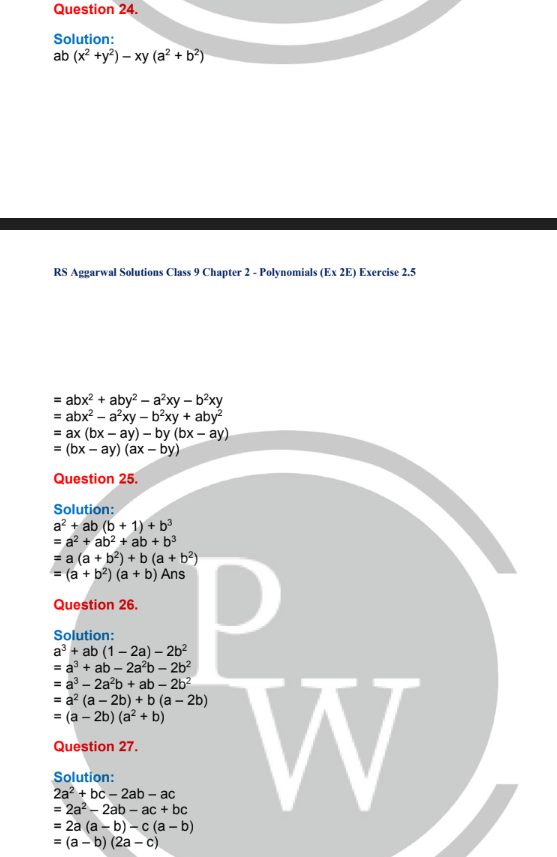
RS Aggarwal Solutions Class 9 Chapter 2 - Polynomials Exercise 2.5
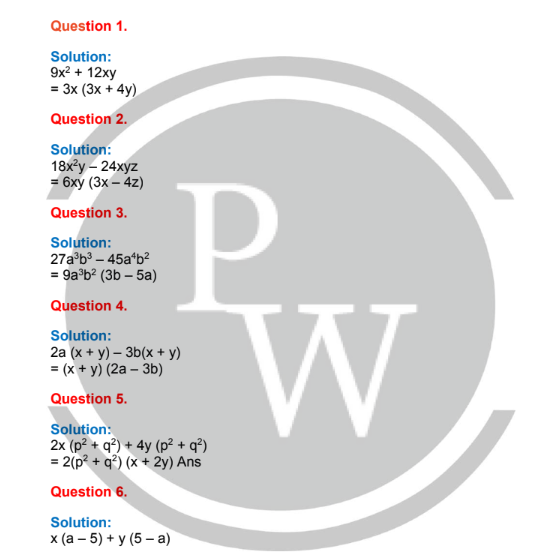
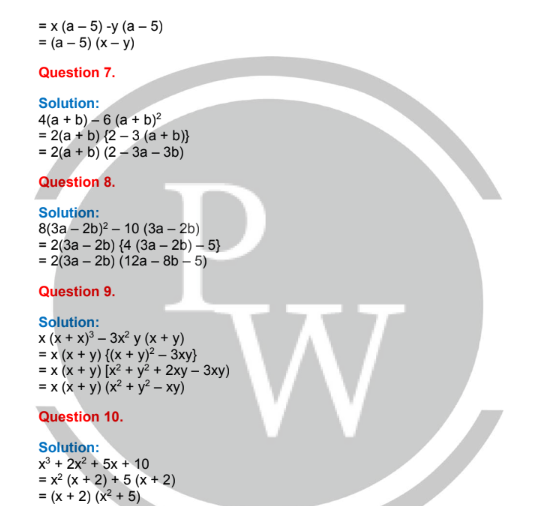
Question 11.
Solution:
x 2 + xy – 2xz – 2yz = x (x + y) -2z (x + y) = (x + y) (x – 2z)
Question 20.
Solution:
3ax – 6ay – 8by + 4bx = 3ax – 6ay + 4bx – 8by = 3a (x – 2y) + 4b (x – 2y) = (x – 2y) (3a + 4b) Ans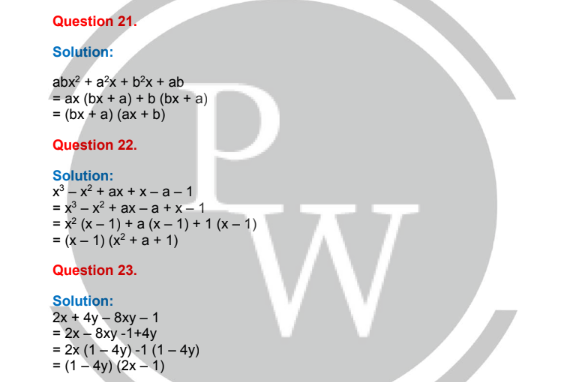
Question 24.
Solution:
ab (x2 +y2) – xy (a2 + b2) = abx2 + aby2 – a2xy – b 2xy = abx2 – a2xy – b2xy + aby2 = ax (bx – ay) – by (bx – ay) = (bx – ay) (ax – by)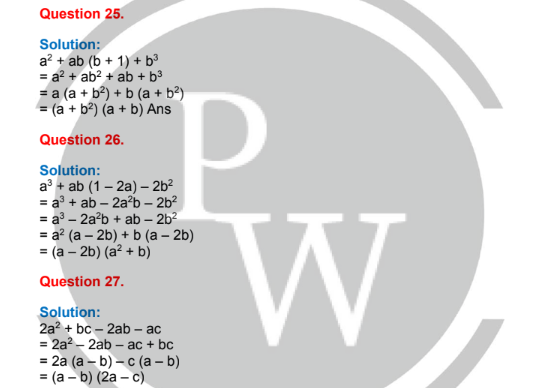
Question 28.
Solution:
= a2x 2 + b2y2 + 2abxy + b2x2 + a2y2 – 2bxy = a2x2 + b2y2 + b2x2 + a2y2 = a2x2 + b2x2 + a2y2 + b2y2 = x2(a2 + b2) + y2(a2 + b2) = (a2 + b2) (x2 + y2)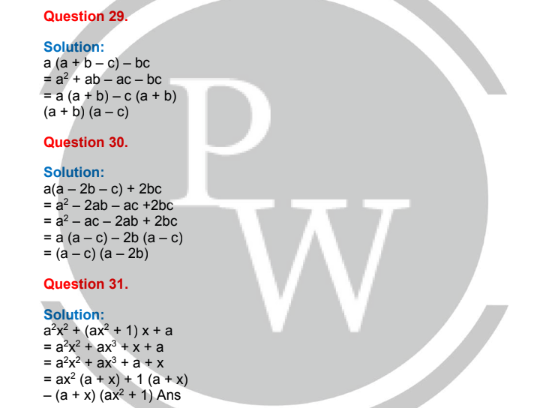
Question 32.
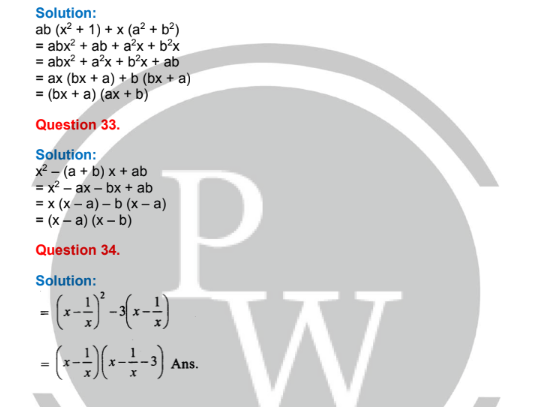
Benefits of RS Aggarwal Solutions Class 9 Maths Chapter 2 Polynomials
The benefits of using RS Aggarwal Solutions for Class 9 Maths Chapter 2 - Polynomials include:Comprehensive Coverage: RS Aggarwal Solutions provide detailed coverage of all topics and exercises in Chapter 2 of the Class 9 Maths syllabus, ensuring that students understand each concept thoroughly.
Step-by-Step Solutions: The solutions offer step-by-step explanations for each problem, making it easier for students to follow and understand the solution process.
Concept Clarity: By using RS Aggarwal Solutions, students can gain clarity on various concepts related to polynomials, including algebraic expressions, factorization, and division algorithm.
Practice Material: The solutions provide ample practice material, allowing students to practice a wide range of problems and improve their problem-solving skills.
Exam Preparation: RS Aggarwal Solutions are beneficial for exam preparation, as they help students revise the chapter, understand different problem-solving techniques, and prepare effectively for exams.
| CBSE Class 9 Maths Syllabus | CBSE Class 9 Science Syllabus |
| CBSE Class 9 Computer Application Syllabus | CBSE Class 9 Social Science Syllabus |
RS Aggarwal Solutions Class 9 Maths Chapter 2 FAQs
What are Polynomials in Mathematics?
How are Polynomials Classified?
What is the Degree of a Polynomial?
What is Polynomial Division?








